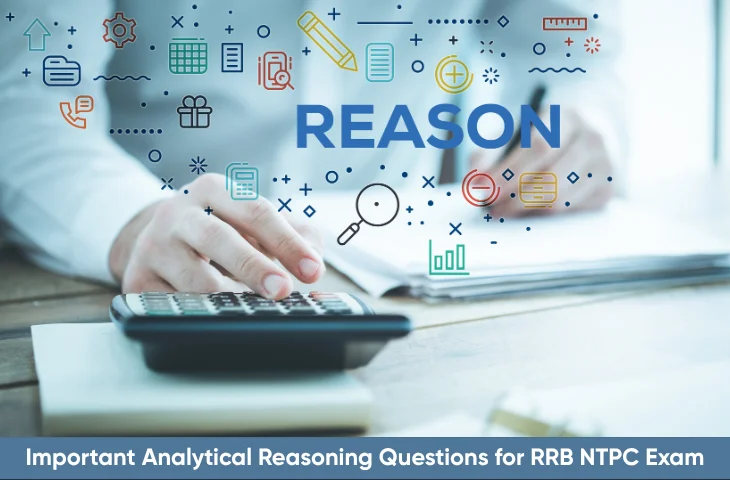Analytical Reasoning Questions for RRB NTPC: The RRB NTPC (Non-Technical Popular Categories) examination is one of the most competitive recruitment exams conducted by the Railway Recruitment Board (RRB). Among its various sections, Analytical Reasoning holds a crucial place as it tests the candidate’s logical thinking, problem-solving ability, and decision-making skills.
This article explores the most important Analytical Reasoning Questions for RRB NTPC, their types, preparation strategies, and sample questions that reflect the actual exam pattern.
Understanding Analytical Reasoning in RRB NTPC
Analytical Reasoning questions aim to evaluate how candidates interpret given information, identify relationships, and deduce conclusions logically. Unlike pure logic puzzles, Analytical Reasoning in RRB NTPC blends pattern recognition, order arrangement, syllogisms, and critical thinking. Some of the reasons why analytical reasoning matters are given below:
- It forms a major part of the General Intelligence and Reasoning section.
- Around 10–12 questions in CBT-1 and 15–20 questions in CBT-2** are based on Analytical Reasoning.
- The difficulty level ranges from easy to moderate, making it a scoring area for well-prepared candidates.
Major Topics Covered under Analytical Reasoning
The following table shows the key reasoning topics asked under the analytical domain in RRB NTPC:
| Topic Name | Type of Questions | Difficulty Level | Weightage (Approx) |
| Arrangement and Ranking | Order-based puzzles, seating, hierarchy | Moderate | 3–4 Questions |
| Blood Relations | Family tree, coded relations | Easy to Moderate | 2–3 Questions |
| Direction Sense | Distance, orientation, angle turns | Easy | 2–3 Questions |
| Syllogism | Logical deductions using statements | Moderate | 2–3 Questions |
| Puzzle (Analytical) | Tabular or box-based data | Moderate to High | 2–4 Questions |
| Statement–Assumption / Conclusion | Logical inference | Moderate | 2–3 Questions |
| Coding–Decoding | Logical pattern or symbol series | Easy | 2–3 Questions |
| Odd One Out | Analytical grouping | Easy | 1–2 Questions |
Types of Analytical Reasoning Questions for RRB NTPC
Let’s explore the most important types of Analytical Reasoning questions that frequently appear in RRB NTPC CBT exams.
1. Seating Arrangement and Ranking
Concept: Candidates are given information about people sitting in a row, around a table, or in an order based on ranks or heights.
Example Question:
Eight friends – A, B, C, D, E, F, G, and H – are sitting in a row facing north. A is to the right of C but not next to D. If E is at one end and H is second from the right, who is sitting exactly in the middle?
Approach:
- Draw a schematic arrangement.
- Mark fixed positions (like ends).
- Place known pairs first.
- Eliminate impossibilities through logical deduction.
Tip:
Practice both linear and circular arrangements regularly.
2. Blood Relations
Concept: Questions are based on family trees, coded relations, or indirect relationships.
Example Question:
Pointing to a man, Priya said, “He is the brother of my mother’s only son.” How is that man related to Priya?
Answer: Father
Approach:
- Identify the reference person.
- Convert the statement step by step.
- Draw simple diagrams to avoid confusion.
3. Direction Sense Test
Concept: Tests the candidate’s ability to visualize directions and distances.
Example Question:
A person walks 4 km north, then 3 km east, and then 2 km south. What is the shortest distance between his starting and ending points?
Solution: Apply Pythagoras theorem:
Distance = √[(3²) + (2²)] = √13 km ≈ 3.6 km
Tip:
Use a compass-based approach — always assume the top is North for diagrammatic clarity.
4. Syllogism
Concept: Involves logical deductions from given statements.
Example Question:
Statements:
- All teachers are readers.
- Some readers are doctors.
Conclusions:
I. Some doctors are teachers.
II. Some readers are teachers.
Answer: Only Conclusion II follows.
Strategy:
- Represent statements using Venn Diagrams.
- Avoid assuming facts not given in the statements.
5. Coding–Decoding
Concept: Identifying patterns in letter/number substitution codes.
Example Question:
If “TRAIN” is written as “UTBJO,” how is “PLANE” written?
Solution: Each letter is replaced by the next letter in the alphabet → “QMBOF.”
Tip:
Watch for alphabetical shifts, symbolic patterns, and numerical codes.
6. Analytical Puzzle
Concept: Requires organizing given data logically.
Example Question:
Four persons — A, B, C, and D — live on different floors of a building having four floors.
- A lives above B.
- C does not live on the top floor.
- D lives below C but not on the ground floor.
Solution:
1st Floor – B
2nd Floor – D
3rd Floor – C
4th Floor – A
Tip:
Practice floor-based, box-based, and schedule-based puzzles for stronger visualization.
7. Statement–Assumption / Conclusion
Concept: Tests critical reasoning and logical inference skills.
Example Question:
Statement: “Every citizen should plant trees.”
Assumption: “Planting trees will reduce pollution.”
Answer: Assumption is implicit, since the statement presumes it.
Tip:
Distinguish between assumptions, arguments, and inferences. Focus on logical rather than emotional reasoning.
Download Free PDF on Top Analytical Reasoning Questions for RRB NTPC
Preparation Strategies for Analytical Reasoning
We have given below some preparation strategies to cover the analytical reasoning topics from the RRB NTPC Syllabus. Check out the details:
| Focus Area | Explanation | Action Steps | Notes |
| Understand the Question Type | Familiarize yourself with the variations and formats of analytical questions seen in past RRB NTPC papers. | Review 5–10 past papers per section; categorize questions (seating, scheduling, puzzles, blood relations, syllogisms). Create a short cheat-sheet of common patterns. | Keep a tagged folder of past papers; use a spreadsheet to log question types. |
| Build a Step-by-Step Approach | Analytical items need clear sequential reasoning – guessing reduces accuracy. | For each question, write down knowns → deductions → conclusion. Train to justify each step in one sentence. Practice solving without skipping steps. | Develop a personal step-template (e.g., Given → Inferences → Constraints → Solution). |
| Practice Mock Tests | Timed practice improves both speed and accuracy for time-bound puzzles. | Take full-length and sectional mocks under exam-like conditions twice a week; simulate strict timing; review raw timings per question type. | Use timed mock platforms or create auto-timers; maintain a mock log (score, errors, time). |
| Use Visualization Tools | Diagrams reduce cognitive load for complex data relationships. | For seating and arrangement problems, draw tables, circles, or matrices before solving. Convert textual clues into visual markers. | Keep a set of template diagrams ready; practice sketching them fast (30–60s). |
| Analyze Mistakes | Post-practice review turns errors into learning — improves logical consistency. | After every mock or practice set, annotate mistakes: cause (misread/clue-miss), correct logic, and a short prevention note. Revisit repeated mistakes weekly. | Maintain an “Error Log” with tags (concept, carelessness, time-pressure) and review it before each study session. |
Analytical Reasoning Questions for RRB NTPC
The table below shows some sample analytical reasoning questions for the RRB NTPC exam. Candidates can also download the Free PDF of the top analytical reasoning questions from this article.
| Question Type | Sample Question | Answer |
| Seating Arrangement | 6 people sit around a circular table. A sits opposite to B. C is to the left of D. Who sits opposite to E? | Depends on arrangement – practice visualization. |
| Blood Relation | R is the father of T, who is the brother of S. How is R related to S? | Father |
| Direction Sense | A walks 2 km north, then turns east for 3 km. Find final displacement. | √13 km |
| Coding–Decoding | If CAT = 24, DOG = 26, what is BAT? | 23 |
| Puzzle | 3 persons – X, Y, Z have different favorite fruits: Apple, Banana, Mango. Y doesn’t like Mango. Z likes Apple. Who likes Banana? | Y |
Key Points
The key points of the article are summarized below:
| Aspect | Details |
| Section Name | General Intelligence and Reasoning |
| Subsection Focus | Analytical Reasoning |
| Number of Questions | 10–20 in CBT 1 & CBT 2 |
| Difficulty Level | Easy to Moderate |
| Scoring Strategy | Logical practice + Diagrammatic visualization |
| Common Mistakes | Over-assumption, skipping diagrams, ignoring clues |
| Best Practice Resource | RRB NTPC previous year papers and sectional mocks |
Analytical Reasoning is not about rote learning, it’s about thinking logically, analyzing patterns, and making precise conclusions. With consistent practice of Analytical Reasoning Questions for RRB NTPC, candidates can master this section and secure an edge in the exam. Remember, accuracy with logic is the key. By revising core topics like puzzles, syllogisms, coding-decoding, and arrangements, you can turn Analytical Reasoning into your strongest scoring area in the RRB NTPC examination.
FAQs
Around 10–12 questions in CBT 1 and 15–20 questions in CBT 2 are based on analytical reasoning concepts.
Puzzles, Blood Relations, Direction Sense, and Syllogisms are among the most frequently asked topics.
No, most questions are of easy to moderate difficulty, but they require quick interpretation and clear logic.
Daily practice of 10–15 reasoning questions, solving previous years’ papers, and attempting topic-wise mocks.
Absolutely. Visual representation simplifies complex problems and reduces the chances of confusion or misinterpretation.
- RRB NTPC Medical Test 2025, Check Post Wise Medical Criteria
- RRB NTPC Undergraduate Notification 2025, Apply for 3058 Posts
- RRB NTPC परीक्षा के लिए स्टेटिक जीके टॉपिक, यहां जानिए सभी टॉपिक्स
- RRB NTPC vs SSC CGL vs IBPS Clerk, Check Complete Analysis
- Importance of RRB NTPC Psycho Test, Know the Details of Test
- रेलवे परीक्षा की तैयारी करें, सारी जानकारी यहां देखें

Hello! This is Arijit Dutta. I am a skilled Content Writer at Oliveboard with nearly 3+ years of experience in crafting engaging, informative, and exam-focused content for the Railways Domain. With a strong command of language and a keen understanding of learner needs, I contribute significantly to Oliveboard’s mission of delivering high-quality educational resources. Passionate about clear communication and continuous learning, I consistently create content that helps government job aspirants achieve their goals. Outside of work, I enjoy playing cricket and listening to music, which helps me stay balanced and creative in my professional journey.
